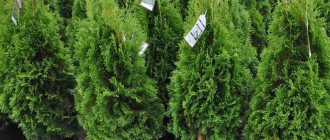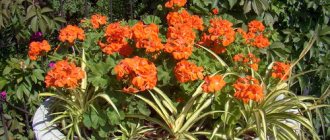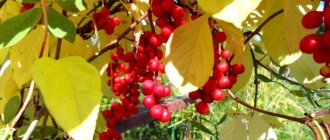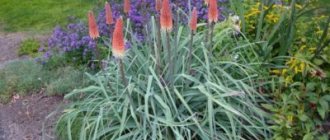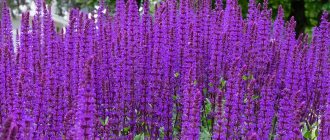Lagurus ovatus (Lagurus ovatus)
Lagurus ovatus is a charming annual cereal plant, also known as Lagurus ovatus. This is the only representative of the haretail genus. The Latin Lagurus has Greek roots, lagos (hare), and oura (tail), i.e. “Hare's tail” - this name is given for the fluffy ovoid panicles of the plant.
Thanks to its long flowering, the haretail looks good in cereal borders and on hills. Suitable for growing in containers, where it is often used in combination with other plants. This makes a great addition to an herb garden or gravel garden. Thanks to its panicles that are soft to the touch, this plant can be recommended for tactile gardening, kindergarten, and for planting along paths.
The inflorescences of the haretail are an excellent component for dry winter bouquets, which do not deteriorate for years and do not lose their attractiveness. To dry, the inflorescences are cut off immediately after blooming, before they lose their creamy white color (as they bloom, they acquire a yellowish-brownish color). Dry for 2-3 weeks in a dry, ventilated place, hanging in bunches.
Interestingly, cuttings of lagurus are traditionally used to decorate floating flower arrangements during the “Battle of the Flowers” on the British island of Jersey. This holiday has been held annually since 1902 and was first dedicated to the coronation of Edward VII and Queen Alexandra, which they wanted to make unforgettable. True, today the battle itself is no longer held, when guests dismantled living decorations and showered each other with flowers (see Battle of Flowers in Jersey).
How to grow Lagurus haretail
Lagurus grows well in any soil, but prefers sandy soil that does not retain water. It tolerates not only sun but also shade; it is a drought-resistant grass. The only exception is that it does not like drafts and excessive humidity, accompanied by stagnant water. Requires frequent weeding to ensure unimpeded supply of oxygen to the roots.
On hot days, the plant needs to be watered regularly. This will help form large panicles. Otherwise, small tops are formed, without the desired splendor.
To improve the growth of the crop, 2-2.5 weeks after planting in a permanent place, the seedlings should be fertilized. For this purpose, it is necessary to use nitrogen-containing fertilizers. As an organic fertilizer, you can use rotted mullein, diluted with water in a ratio of 1:10.
In the middle of the growing season, a comprehensive mineral supplement containing all the necessary nutrients for the active growth and development of the plant is suitable.
To achieve massive flowering, faded panicles need to be plucked off regularly. This will help to get new inflorescences and extend the flowering period.
Description of Lagurus
Radermacher: home care and cultivation features
Haretail in garden design photo on a flower bed
Lagurus comes from the Mediterranean coast, so it grows well in dry, rocky soils. In a mild climate, it can delight with its shaggy spikelets for about two years, but it will not survive the harsher winters of cold regions. As an annual plant, lagurus blooms during the last two summer months, and in warm regions it produces spikelets in early May.
Under favorable conditions, the stems of the cereal grow about 60 cm in height, the slightly elongated spikelet is 2-3 cm long. The pile of the spikelet is long - about 2.5-4 cm, the color is light. The leaves are long (about 20 cm), flat, attached to the base of the stem, and are also covered with small fibers. The foliage is greenish-silver in color. The fluffiness and light colors give the plant a particularly cute look.
Popular varieties of Lagurus (Haretail)
In the genus Lagurus there is only one type of crop - ovoid (Lagurus ovatus).
The most common plant varieties:
- Bunny tail. Grows up to 50 cm in height. The shape of the panicle is spicate or ovoid. Color – gray-white. The scales are completely covered with soft hairs. In dry form, the culture retains its properties for several years.
- Lesya . Multi-stemmed plant with soft edges. The height of the crop ranges from 25 to 60 cm. The length of the spikelet is 1.5-4 cm, width – up to 2 cm.
- Steppe wanderer . Annual, about 50 cm high. The leaves are flat, narrow, the inflorescences are spike-shaped panicles. The young culture has spikelets of light green color, the mature one is pure white.
Brief characteristics of Lagurus
Yucca garden: planting and care, photos, cultivation features, reproduction
The stem of the plant and its leaves are silver-green in color. The length of the stem reaches 60 cm. The leaves are attached to it at the very base and reach a length of 20 cm. The spikelets have a lush, elongated structure. Their length is 2–3 cm. The spikelets are covered with a light-colored edge.
Its spikelets usually appear in July, but in warm regions they can be observed in early May.
Haretail can be grown both in pots on the balcony and in the garden
This plant is easy to care for. Any soil is suitable for it. The haretail is light-loving, but a little shade will not harm it. Frequent watering is recommended, especially at high air temperatures and the absence of natural access to moisture in the form of rain.
Growing and care
Features of growing Japanese spirea: planting, care and propagation rules
The haretail is not picky about the type of soil and grows well on any soil. The plant is light-loving, but a little shade is allowed. Suitable for growing in the garden or in pots on the balcony. It is drought tolerant, but requires daily watering in hot weather, especially when grown indoors where raindrops cannot reach.
To achieve the maximum height of spikelets that will be used in bouquet arrangements, lagurus needs to be provided with optimal development conditions. The soil needs to be fertile and loose, you can add sand. Before flowering begins, nitrogen fertilizer is applied at intervals of 10 days along with watering. After the formation of spikelets, feed them twice with complex fertilizer. Access to light is required for 12-14 hours.
Spikelets for bouquets are cut before they begin to turn yellow. This will prevent shedding and maintain an attractive appearance for a long time. Before cutting, wait for the dew drops to dry, that is, it is done closer to lunch or at the beginning of the evening.
The haretail is resistant to diseases and pests, as well as weather conditions. Excess nitrogen fertilizer causes stems to break off and greenery to become more saturated (even dark) in color. To avoid this, but give the grain enough nutrients, you can replace one of the portions of fertilizer with horn flour.
Usage and partners
This medium-sized grass is suitable for edging rocky compositions and borders. For decorating a rock garden, a patchwork method of planting haretails is suitable, that is, in small groups.
With this grass you can fill the space between brighter flowering annuals or bushes, suitable for use in a rose garden or in front of fruit bushes.
https://youtube.com/watch?v=nEnSmCWySu4
On the site, the haretail is suitable for proximity to unpretentious plants that prefer poor soil. Bright flowers look great against the background of its pale greens, enlivening the composition.
An interesting result is the proximity to other herbaceous perennials, which are distinguished by their dark, rich foliage color. In this case, it is recommended to combine it with Iresine Herbst, Creeping Tenacious, Coleus Blume.
Planting and care
This plant is grown in two ways: seeds and seedlings, depending on how early flowering the gardener needs.
Seeds
Plant seeds can be planted in the ground only after the necessary weather conditions have been established.
As a rule, haretail seeds are planted in May.
Planting a plant with seeds consists of the following steps.
- Choose a suitable location.
- Fluff up the ground.
- Immerse the planting material a couple of centimeters.
- Water.
- Wait for the first sprouts (after about two weeks).
- Thin out the planting so that only the strongest stems remain at a distance of 10 centimeters from each other.
Seedlings
Sowing haretail for seedlings is carried out in March-April in nutritious loose soil
The use of seedlings allows you to get results in a short time. To plant a plant using this method, you must do the following:
Recent postsPlanting grapes in the fall as an alternative to spring: what are the benefits? Technology for pruning cherries in the fall: diagrams and instructions for beginnersBeautiful maple tree in landscape design: 60 photos of successful application ideas
- Plant the seeds in pots.
- After two weeks, place the box with the sprouts on a warm windowsill, closer to the light.
- Thin out seedlings if they grow too densely.
- After suitable weather has established, plant the seedlings in the ground at a distance of 10 cm from each other.
- Water the beds generously.
How to care
In the absence of rain, the plant should be watered at least twice a week.
Caring for the plant is not difficult, but some nuances should still be taken into account:
- the flower loves water and does not do well in dry weather, so you always need to monitor the level of soil moisture;
- fertilizing before the flowering period - with nitrogen-based fertilizers twice with a difference of about 10 days - ensures that the inflorescences will be as lush as possible;
- For decorative use of spikelets after cutting, they must be hung freely until they are completely dry.
Reproduction
Lagurus is propagated by seed. At the same time, depending on the growing conditions, sowing is carried out at different times of the year. Pre-growing lagurus seedlings is also permissible. Each method has its own characteristics and disadvantages.
Sowing seedlings
To obtain several individuals of the crop, it is better to grow lagurus using seedlings. Sowing is carried out in small flat containers in mid-spring. For seeds, choose high-quality loose soil with an optimal amount of nutrients in the ground. Seedlings require a good drainage layer, so small holes are made in the containers in advance. 3-5 seeds are planted in pots, placing them at a distance of 3-4 cm from each other. The seeds are deepened into the soil by 0.5 cm, after which the seedlings are covered with a layer of soil.
To obtain quick shoots, pots with plants are covered with film or glass, creating greenhouse conditions. The film must be removed regularly and the bushes ventilated. Plants grown in greenhouse conditions have greater vigor and growth rate.
As soon as the shoots appear, the greenhouse conditions are removed. The pots are placed in a warm, dry place with the optimal amount of sunlight. Southern windows are considered optimal conditions for keeping seedlings. Water the seedlings regularly, taking care not to damage the sprouts or flood the soil.
Before planting grown crops in a permanent habitat in open ground, the seedlings are hardened off. To do this, the bushes are regularly taken outside, increasing the hardening time. By the time constant heat is formed, the seedlings are planted in a permanent place at a distance of 10-15 cm from each other.
Sowing seeds in the ground in spring
In the spring, starting from the end of April, lagurus seeds can be planted directly in open ground. The germination rate of such seedlings is much less than that of seedlings. In addition, seeds require high-quality care.
Before sowing, the seeds are mixed with a layer of fine sand. The soil at the planting site is well loosened, holes about 3 cm deep are created. Sowing is carried out in holes watered with water. The distance between the rows should be at least 10 cm. After sowing, the seeds are sprinkled with earth. Under normal climatic conditions, seeds sprout within 2 weeks after sowing. After emergence, the seedlings are provided with a regular supply of water to the soil, as well as sufficient lighting.
After 3 or more permanent leaves appear on the seedlings, the seedlings are picked. You can plant bushes in a permanent habitat within two weeks after germination. Further care is carried out as usual.
Sowing before winter
Since lagurus does not survive in harsh winters, seeds are sown before winter only in conditions with warm winters. After the onset of frost, fresh haretail seeds are placed in the ground, covered with a layer of spruce branches or dry foliage. The seeds undergo natural stratification over the winter, after which they germinate in the spring and produce new crops.
Growing and caring for lagurus
The haretail is unpretentious to soil composition and will grow well in any soil. Loves light, slight shadow is acceptable. This cereal can be grown in the garden and in pots on the balcony. It is drought-resistant, but during hot weather, water it daily, especially if you grow it indoors, because precipitation will not be able to get there.
Composition of soil and fertilizing
To obtain the highest possible spikelets, which will look especially beautiful in flower arrangements, it is necessary to ensure optimal development conditions. Plant in fertile, loose soil; adding sand is helpful. Before flowering, apply nitrogen fertilizers every 10 days along with watering. When the spikelets appear, you can feed them a couple of times with complex mineral fertilizer.
It is important to provide 12-14 hours of daylight
When to cut lagurus
To prevent spikelets for bouquets from falling off and maintaining an attractive appearance for a long time, they need to be cut before they begin to turn yellow. Before cutting, you need to wait for the dew to dry, that is, it is better to do this in the afternoon or early evening.
Diseases and pests
Lagurus has strong immunity, is resistant to diseases and parasites, as well as changeable weather conditions. Excess nitrogen-containing fertilizers can cause brittle stems and a more saturated (darker) color of greens. To prevent this from happening, and to ensure that the cereal receives a sufficient amount of nutrients, replace one of the doses of fertilizing with horn flour.
Haretail in landscape design
When choosing an original plant for planting on a site, flower growers very often choose ornamental grasses. For example, lagurus ovoid, or as it is also called “haretail”. This is an unpretentious and unusual plant with small spikelets that look like fluffy hare's feet. Lagurus prefers dry and rocky soil. Its homeland is the Mediterranean coast. In areas with warm and mild climates, it grows as a biennial plant. But in cold conditions it is an annual crop. The haretail plant grows no more than 60 cm in length. Flat and long leaves up to 20 cm are tightly attached to the stem. Its small flowers are collected in fluffy spikelets, the color depends on the climate in which the plant grows.
On a personal plot, the haretail will perfectly decorate borders, rocky rock gardens, and garden paths. Lagurus combines in an original way with large, brightly flowering plants, as well as with the lush greenery of herbaceous perennials. When creating a flower arrangement on the site, as neighbors of the haretail, choose unpretentious plants that can grow in poor soil.
Thanks to its fairly rapid growth, every season your area will be decorated with a new fluffy bush. And by autumn, when all other plants fade and die, the spikelets of the haretail will acquire a yellowish-brown tint and will continue to decorate your area. In addition, you can use haretail spikelets in floristry. Fluffy bunny tails add sophistication to floral bouquets.
Spreading
The haretail has a wide distribution. Culture in wild conditions is found almost everywhere. North America is considered the homeland of lagurus. However, under natural growing conditions, the haretail is found in the western part of Asia, in the Caucasus. You can meet the culture throughout Europe, in Italy and Spain. Some varieties of hybrid lagurus are found in Tunisia, Libya, and Morocco.
In Russia, haretail is cultivated as an ornamental plant. In the European part, lagurus is used to decorate gardens and parks. The plant, as an annual, can be grown in temperate climates and in areas with colder northern climates. The culture can be found in Siberia and the Urals.
The haretail grows in places with sandy soil. Wild lagurus thickets are found in coastal areas, where the crop quickly covers and covers sandy beaches. The plant prefers to live on rocky soils, with an optimal content of drainage layer in the soil. Under natural conditions, the culture often lives in pastures, roadside areas and wastelands.
Plant care
This flower is not at all demanding and requires a minimum of care. The plant loves light and needs plenty of watering in hot weather.
To achieve maximum length of ears, it is better to grow the plant on fertile soil, loose, with the addition of sand. Fertilizers containing nitrogen must be applied every 10 days. When spikelets begin to form, the flower should be fed twice with complex fertilizers. Daylight hours for this flower should be at least 12 hours.
If you use haretail to make bouquets, you need to choose the right time to cut the inflorescences. This should be done early in the morning or late in the evening. The cut panicles must be hung vertically so that they hang freely. The haretail should hang like this until it is completely dry.
Already dried inflorescences can be painted in a variety of colors. For this purpose, only special paints are used, which are sold in specialized stores for creativity.
Cutting ears of corn into bouquets
If you want to cut the ears so that they can stand in a vase in the winter or for use in floral arrangements, this should be done without delay, even before signs of their ripening and yellowing begin to appear, otherwise they will quickly fall off later. Cutting should not be done during dew, i.e. early in the morning or in the evening. It is better to do this on a dry and sunny day at noon or in the afternoon.
The cut shoots are loosely tied into small bunches, and then hung with their heads down for final drying. It is acceptable to dry them and lay them out on a dry surface, but then they may look squashed. After drying, the bouquet can be placed untied in a vase or left hanging for subsequent work and creativity.
It is not recommended to place dry bouquets with haretail in the sun, as it quickly fades and loses its decorative effect.
Agricultural technology for growing from seeds
Planting and caring for a haretail is not a very difficult task. The plant is very unpretentious. You just need to follow the basic recommendations. The crop is grown only from seeds: sown directly into the soil or pre-grown seedlings. Let's look at each method in more detail.
Seedless method
You can start the planting procedure from the second ten days of May. It is necessary that the soil and air warm up sufficiently.
- If lagurus is already growing in your flowerbed, then you can collect the seed material yourself. When the inflorescences acquire a yellowish tint and begin to dry out a little, they should be collected and placed on clean paper to dry at some distance from each other.
- Next, completely dried buds need to be crushed with your hands and blown. The seeds will separate from the fluffy part. Planting material collected from its plants can remain in good condition for quite a long time. Place the seeds in a paper bag.
- If you decide to plant haretail for the first time, then purchase seeds at any garden or flower shop. Prepare the area in advance. Dig it up and clear it of weeds. Level with a rake.
- You can plant it in several ways: simply press it gently into the ground to a depth of half a centimeter or first make shallow grooves. Place the seeds in them at intervals of at least 10 cm from each other.
- Next, use a spray bottle to moisten the soil well. Some gardeners sprinkle a very thin layer of humus on top, which perfectly retains moisture in the soil. Sprouts appear much faster in this case.
If you want to achieve earlier shoots, then cover the planted plants with non-woven material: after 14 days you will observe friendly shoots. In the middle of the summer season, the haretail will delight you with its first flowering.
Growing using seedlings
the procedure for sowing planting material must begin in the first ten days of April. Stock up on containers, boxes or other suitable containers in advance
It is important that there are drainage holes at the bottom
- As an option: plant several seeds in small pots at a distance of 3 - 4 cm. Prepare a nutritious soil mixture several weeks in advance. Mix humus and coarse sand well and bake in the oven at 180 degrees for 20 minutes.
- Next, leave the soil for several weeks so that the microflora is restored. Then you can start planting the seeds. After planting, sprinkle with substrate - the layer should be approximately half a centimeter. Next, moisten the soil and cover with a piece of glass or a plastic bag.
- Place the containers in a dark place, do not forget to ventilate and moisten the soil. When shoots appear after 14 days, the shelter can be completely removed and the pots can be moved to the windowsill.
- 10 - 12 days before planting (in the second half of May) in open ground, gradually begin to accustom the plants to fresh air. Take it outside for a very short period of time at first, but increase it every day. Next, you can plant young plants in a permanent place.
Features of planting in open soil
It is advisable to plant seedlings in a well-lit area. If you plan to plant on the semi-shaded side of the garden, then you may not expect too lush flowering.
This crop cannot withstand stagnant moisture in the soil at all, so it is better to grow haretail on a small hill. Prepare the site and planting holes at intervals of 20 cm.
The soil should be well-drained, loose and light, although lagurus grows well on rocky soil. Sprouts should be replanted using the transshipment method so as not to disturb the fragile root system. After planting, water and mulch with humus.
How to plant Haretail
Top 55 blue flowers and plants for your home and garden. indoor and outdoor, perennial and annual (85+ photos & videos) + reviews
For sowing, you should purchase Lagurus seeds. Prepare the soil by breaking up any clumps on the surface with a rake. The smaller the seeds, the more you need to get the best results. They need to be sown immediately in open ground, to a depth of 0.5 cm. If the seeds are from 2 to 4 mm in size, plant them at a distance of several centimeters from each other. You can sow the seeds in a pile: dig a small hole and place 2 to 5 seeds in it. Cover the seeds with soil no more than 2 cm high; if your soil is very heavy, add a little sand. The soil on top should be compacted a little. Alternatively, you can plant Lagurus in a pot or other container.
Lagurus seeds
The second option for sowing is at the end of winter in boxes, pots or disposable cups. The optimal soil for filling containers is a mixture of sand and humus soil. In order for the plant to take root better, after a few leaves appear, the seedlings need to be pricked. The width between plants should not exceed 10-15 cm.
In order for Lagurus hare's tail to grow quickly, the ground needs to be watered regularly, and you can additionally mulch the top. Try to avoid watering on sunny days to minimize the amount of moisture lost through evaporation. If your plant is in a pot, regularly check the top layer of soil in the container for moisture in the soil.
The main condition for successful planting is that all work should be carried out no earlier than the last ten days of April or early May, so that the soil warms up well. This will help avoid spring frosts.
Ornamental grass haretail, growing tips
When you plan to create a flowerbed, you try to find that very highlight that you will admire and be surprised by.
Flowerbeds can be decorated not only with beautiful flowers, but also with ornamental grasses, which, unfortunately, are often forgotten. Many gardeners call ornamental grasses dried flowers; they are easy to grow, and you can diversify your lawn, mixborder or flower bed in an interesting and unusual way. So, for example, we will talk about the haretail. Lagurus, or in common parlance haretail, is an ornamental grass that looks like a hare's tail, which is where it apparently got its second name. The inflorescences have many villi, the result is fluffy panicles, they can have different shades and shapes (cylindrical or oval), the size of the panicles is 3-4 cm. The leaves are soft, the height of the plants reaches 50-60 cm. To make a bouquet of dried flowers, the haretail is cut off before the panicles ripen, so that the seeds do not fall to the ground. Haretail is an annual grass. Seeds are planted immediately in open ground in mid-May or sown for seedlings at the end of April. Having grown the seedlings, in May they are transplanted into open ground, and flowering in such plants occurs much earlier than in those that are only sown in May.
How to plant haretail (lagurus) seeds for seedlings
At the end of April, fill the pots with light nutritious soil mixture, make holes, bury the seeds 2-3 cm, and water. In May, seedlings can be planted in a permanent place in open ground. The distance between seedlings is 10 cm.
How to plant haretail in open ground
Before planting, the soil is loosened, leveled and holes 2-3 cm deep are made. Having laid the seeds, they are covered with soil and watered. After 2-3 weeks, the first shoots appear. Thin out, leaving the strongest seedlings at a distance of 10 cm from each other. Removed specimens can be planted on an alpine hill or in a rock garden.
The haretail blooms from June to August.
Care
Choose a sunny area for planting the haretail; light partial shade is also acceptable.
The haretail loves moisture and does not tolerate even the slightest drought. Water 2 times a week, and every other day during drought, depending on how quickly the soil dries.
Fertilize with nitrogen fertilizer. Twice before flowering and then every 10 days. Then the plant will be lush and there will be more panicles.
The whitetail overwinters only in warm areas. In the spring, after a warm winter, the spikelets may become speckled in the flowerbed, which means that the seed pods opened before cutting and fell to the ground.
Use in a bouquet
To use in a winter bouquet, haretail is cut before flowering, when the panicles are still green. It is better to do this in the morning or evening, when there is no dew or rain. After which they are tied into small bunches and hung with panicles down (in the sun during the day, in a barn, attic or attic at night), waiting for them to dry for 10-14 days. Further, the dried flowers are used in various flower arrangements. And even for creativity they paint with special paint.
You can buy paint in stores or use a budget option by diluting the dye in water. On the street, use a spray bottle or aerosol to spray the flowers and dry them for 2 days. It is not recommended to do this at home, as you will paint the bathtub or walls. As a natural dye, you can use decoctions of chamomile, potato tops, linden, maple, and cornflowers.
Dry haretail is stored in cardboard boxes.
Even children can handle growing lagurus, so don’t hesitate and feel free to buy seeds.
Preparation of dried flowers
If you plan to use fluffy “tails” in creating floral arrangements, cut off the lagurus as soon as it starts to spike. Do not wait, otherwise the fading panicles will take on a dirty tint. Cleaning is carried out in clear weather, late morning or early evening, so that there are no dew drops on the inflorescences. For drying, the collected ears of corn are tied into small sheaves and hung in a ventilated room or laid out in a thin layer on a flat surface. Keep in mind that haretails dried in the shade retain their natural color (green or creamy yellow), but in bright sunlight the inflorescences will fade white, making them very easy to paint. You can give the “cones” the desired shade using floral spray paint (sold in specialized stores) or natural dyes (decoctions of cornflower, linden, potato tops, onion peels, etc.)
What kind of composition you get from lagurus depends on your imagination: you can collect multi-colored fluffies into a voluminous bouquet or add them to a complex “work” of other dried flowers (lunaria, kermek, immortelle, gomphrena, celosia). Timely collected and properly prepared haretail panicles remain attractive for several years.
Date: 04/15/2015.
Haretail: application in garden design
Haretail can be planted along paths or in border plantings. Due to their short stature, they look great on alpine slides and in other stone compositions. Lagurus is included in mixborders, where they successfully shade bright flowers and other foliage plants, especially in multi-level plantings.
The culture goes well with other green spaces and looks great when planted in patchwork
The grain will help fill the empty space between other crops in the garden.
Use of dried Lagurus flowers in floristry
Haretail is widely used to create dry bouquets. Despite the fact that the price of Lagurus is low, this plant retains its elegant appearance for a long time, lends itself well to painting and does not crumble.
The spikelets need to be cut before they are fully ripe. Drying should take place in a dark, dry and well-ventilated area.
How to paint Lagurus or Haretail? For this, it is best to use special aerosol dyes. The sprayer ensures uniform tinting of the inflorescences. The procedure should be performed outdoors or over a bathtub. This will help avoid paint splattering. The panicle must be dried for at least 2 days.
Spikelets painted in bright colors will become the basis for an original bouquet.
Dried haretail can be used to create flower arrangements. The plant can also be used in combination with other flowers. A bouquet of Lagurus and Cotton looks beautiful in the house.
Application in floristry
If this plant is grown for the purpose of its further use in floristry, the spikelets must be cut off immediately after the start of flowering, since during this period they are the lightest and most beautiful.
Delicate shades of painted lagurus add beauty, tenderness and fluffiness to a bouquet of dried flowers.
The light shade of the panicles is an additional advantage, because in this case they can be easily painted in any color.
After cutting, the spikelets are hung in a drying room. Collected in time, properly dried inflorescences can be stored for several years and used to create various compositions.
The number of options for their use is not limited and depends solely on the florist’s imagination. Spikelets can be arranged into an independent multi-colored bouquet or complement a ready-made flower group.
Beautiful compositions of dyed bunny tail in the photo
Pink haretail with cotton and lavender create a very delicate composition
The haretail can be used to form charming bridal bouquets. In combination with pine cones and cotton, the haretail fits perfectly into a winter bouquet. Multi-colored lagurus spikelets in pastel colors look good in such an original bouquet.
Undyed haretail looks great paired with bright dried flowers Red lagurus pairs beautifully with lavender and white cotton
Delicate colored haretail can be added to bridal bouquets. Lagurus in combination with cotton and floral decor creates a beautiful composition
How to paint haretail at home
Dry spikelets of the plant can be painted in various shades. This technique allows you to create unique and effective compositions. Such cheerful colorful bouquets can delight the eye all winter.
Coloring can be done at home. You can purchase a special floral spray at craft or flower shops, but it is not cheap.
While floral paint is usually quite bright and has a pungent chemical odor that remains on the spikelet, a solution of food coloring or a decoction of a coloring plant, poured into a spray bottle, will give the plant a more delicate shade and eliminate the need to “breathe chemicals.”
A simple alternative is to color the inflorescences with food coloring, watercolor, or gouache diluted with water. The use of natural dyes is also allowed - a decoction of cornflower, linden, sage, chamomile, potato tops, onion peels, etc.
The most convenient way is to use a regular spray bottle, spraying the composition onto the spikelets. In order not to stain the environment, it is better to carry out the procedure outside. As a last resort, you can do this in the bathroom.
Dyed spikelets are hung with the spikelets facing down and dried for two days.
Haretail: planting and caring for compact grass with fluffy inflorescences
Harestail (Lagurus) is a beautiful ornamental grass known for its plump white flower heads that resemble a rabbit's tail. The plant is native to the Mediterranean basin and surrounding regions, from the Azores and Canary Islands to Crimea and Saudi Arabia. It has also naturalized in Australia, New Zealand, Ireland and Great Britain, as well as in various places in North and South America. The haretail belongs to the genus of annual plants of the grass family, consisting of a single species - the ovate haretail (Lagurus ovatus).
Species that were once considered part of the genus Lagurus have today been transferred to other genera.
Thus, the cylindrical haretail (Lagurus cylindricus) is today called the cylindrical imperata (Imperata cylindrica), Lagurus paniculatus is the Ceylon citronella (Cymbopogon nardus), and the species Lagurus schoenanthus is the cymbopogon (Cymbopogon schoenanthus).
Haretail grows as a compact ornamental grass, reaching 30 cm in height and about 20 cm in width. The ornamental value of this beautiful grass comes from its fluffy white oval flowers that begin to appear in early summer. Haretail flowers turn a yellowish-brown color as they enter the fall season. They can be kept for winter interest. The stems with dried fluffy flowers can also be used in dried flower arrangements.
Growing MUSHROOMS on coffee grounds: a rich harvest in just 20 days!
In some areas, as is the case with many other types of ornamental grasses, haretail plants are considered invasive due to their adaptability to different climates and their ease of propagation.
- Light: Like all ornamental grasses, haretails bloom best in full sun. They can tolerate partial shade, but flowering will be reduced and the plants may become leggy. Ornamental grasses grown in full sun will be strong enough to withstand strong winds on their own. However, herbs with large flower heads growing in partial shade may have weaker stems and are more likely to fall apart in the wind. Additionally, grasses grown with too much nitrogen fertilizer will encourage tall, weak stems.
- Mulching: The hare will benefit from a 5-8 cm layer of bark mulch added in the spring. This will help maintain soil moisture and prevent weeds from forming between the grass.
- Soil.Ornamental grasses are not picky about soil conditions. They will grow from poor to fertile soils. However, adding compost to the soil will help the overall vigor of the haretail.
- Fertilizer: Within a month of planting, give the new haretail plants nutritious food in the form of organic or synthetic fertilizers to help them grow strong. Spread evenly over the soil, then water well. Be sure to read the label to find out how much to fertilize and how often.
Haretail (lagurus) - an elegant grass in the flowerbed
Recently, many gardeners have been decorating their plots in a simple and natural style, preferring simple herbs to exotic plants. They make the garden cozy, and some specimens are quite original and create spectacular flower arrangements. This includes the Haretail, which is loved by many gardeners for its fluffy tails.
Brief history of origin
- There are several variants of the plant - Lagurus Ovate, Hare's tail, Haretail. It belongs to the Poa family or Poaceae. It has been used in culture since the 16th century. The name Lagurus is translated from Greek as “hare’s tail”, and the French call the plant “rabbit’s tail”.
- In regions with a cool, temperate climate, the plant cannot withstand harsh winters, so it is often grown as an annual plant. Unusual flowering occurs in July and continues until the end of the summer season.
Morphological characteristics
- On the coasts of Mediterranean countries, lagurus delights with its unusual fluffy cones for at least several years: the climate there is warmer. Spikelets form already in the second half of May. When the panicles bloom completely, the bushes resemble snow-white, shaggy and delicate clouds.
- Under natural conditions, the haretail reproduces by self-seeding, so it can be called perennial. The seeds are light brown in color, oblong. They are formed in spikelets of inflorescences after the flowering period.
- It is loved all over the world not only by landscape designers, but also by florists. Dried twigs are also very decorative and are used in various flower arrangements.
- The haretail also grows in northern Africa and East Asia, on rocky slopes. For this reason, it has a very well developed and strong root system. It is represented by a tuberous rhizome. Grows successfully on dry soil, in rocky crevices.
- Lagurus usually stretches 50 - 60 cm in height, but there are very miniature varietal varieties - their aerial parts are only 18 - 20 cm long. For example, the Nanus variety.
- The leaf blades are elongated, up to 25 cm long, lanceolate, light green in color with slight pubescence.
- Despite the thinness and fragility of the stems, their structure is quite dense and flexible. Color dark green. An inflorescence or spikelet is formed on the apical part. A lot of stems grow, resulting in quite dense growth. The length of the inflorescences is not very long - only 3 - 4 cm. The shape of the panicles with white hairs is cylindrical or elongated oval.
The most delicate and “airy” inflorescences are white. But climatic conditions and the composition of the soil can have an impact, and the tonality changes to light shades of green, soft lilac or yellow.
Application
Low-growing varieties are convenient to plant along garden paths or borders. Taller ones look beautiful in rock gardens, stone gardens, and mixborders. You can complicate the task and plant plants in several tiers, although a single-tiered flower garden looks great.
Lagurus fits perfectly as a single solo plant if planted around the perimeter of a green lawn. But the plant looks most attractive in a group with other herbs or cereals. Lagurus looks very good as a background plant, shading off brighter flowers: asters, lilies, bright yellow chrysanthemums and others.
When the fluffy cones are fully formed, they are often collected and used as dried flowers for various bouquets, and they can also be painted in different colors and create an unusual colorful composition.
The most famous varieties are the following: Hare's Tail with grayish-white inflorescences about 4 cm long and several centimeters wide. The height of the bush is no more than 30 cm; Steppe Wanderer - has good resistance to pests and various diseases, the inflorescences are first light green and then turn white, the height of the bush reaches half a meter; Nanus - low-growing, height no more than 15 - 20 cm, Lesya - inflorescences are very fluffy and dense, color - white with a grayish tint.
Haretail in the cultural environment
This plant is distributed throughout the world and is actively used in floristry and landscape design.
Where does it grow?
In our country, lagurus takes root best in regions with a warm climate, where it can survive relatively warm winters:
- Krasnodar region,
- Volgograd region,
- Rostov region,
- Stavropol region,
- Republic of Kalmykia, etc.
In the world, it is distributed in temperate, subtropical, and tropical zones: Egypt, Israel, Greece, Bulgaria, Turkey, Ukraine, Croatia, Italy, etc.
In the wild, the haretail grows on sandy coastal soils
In a number of countries, these fluffy spikelets are cultivated.
Haretail: where does it grow?
The natural range of the haretail is located in almost the entire Northern Hemisphere, with the exception of North America. In the wild, it is found everywhere in coastal dry grasslands in the Mediterranean, Eastern Europe, Western Asia and the Caucasus. In our country, it grows mainly in the southern regions with a mild, subtropical climate.
In culture, haretail is grown almost everywhere in both hemispheres as a very valuable, ornamental, garden plant. In northern regions, in temperate climates, it is cultivated exclusively as an annual.



